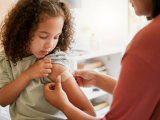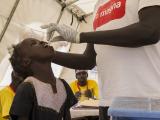Apr 18, 2012
Laos set to launch seasonal flu vaccine campaign
Laos will launch its first seasonal flu vaccination campaign on Apr 24, the next phase of a 6-year collaboration between the US Centers for Disease Control and Prevention (CDC) and World Health Organization (WHO) to improve the country's surveillance for flu and severe respiratory illnesses, the CDC said yesterday in a statement. Walgreens has donated 375,000 doses of the vaccine, which Lao officials will target to high-risk groups such as pregnant women. The CDC said the country's capacity to distribute and administer flu vaccine has improved, and Laos successfully conducted a 2009 H1N1 immunization campaign with vaccine provided by the WHO and Australia. The CDC said the Laos flu season coincides with the rainy season, which starts in July and runs through December. Recent surveillance suggests that the flu viruses in Laos are the same as those circulating in the Northern Hemisphere, which means that the donated vaccine should help prevent disease in the country. The Lao vaccine program is a workable template for initiating future flu vaccine programs in developing countries. Joe Breese, MD, chief of the CDC's Influenza Epidemiology and Prevention Branch, said in the statement that the last 3 years of surveillance in Laos suggests the flu vaccine would be a useful tool for reducing respiratory illnesses. Lisa Koonin, MN, MPH, senior advisor to the CDC's Influenza Coordination Unit, added, "The vaccine program in Lao PDR is a great example of how partnerships between public health organizations and private companies can lead to important gains in the fight against influenza.
Apr 17 CDC statement
Oregon outbreak tests find E coli O157 in raw milk
Lab tests have identified Escherichia coli O157:H7 in samples of leftover raw milk recovered from a household in an investigation of an outbreak that has sickened five children so far, with four of them hospitalized, the Oregon Health Authority (OHA) announced in a press release yesterday. Samples positive for E coli were also recovered from rectal swabs of two of four cows and multiple manure and other environmental samples collected from Foundation Farms, the dairy linked to the outbreak. Katrina Hedberg, MD, MPH, Oregon's state epidemiologist, in a press released warned people not to drink raw milk or consume any products made from raw milk from Foundation Farms or any other sources. "Pasteurized milk is the only safe milk, because it kills harmful bacteria such as E coli O157," she said. Three of the hospitalized children have hemolytic uremic syndrome, a potentially fatal type of kidney failure. Lab confirmation of HUS is pending for the other hospitalized child. The OHA said 13 other people who drank raw milk from Foundation Farms have reported diarrhea, but the cases have not been lab-confirmed. The farm distributed the raw milk to 48 households as part of a herd-share program.
Apr 17 OHA press release
H5N1 hits cluster of chicken farms in China
An outbreak of H5N1 avian influenza has hit several farms in China's Ningxia Hui autonomous region, Chinese officials said in a report filed with the World Organization for Animal Health (OIE). It said 10,468 of 23,880 affected chickens died, and another 84,532 were destroyed to arrest the outbreak, for a total of 95,000 chickens lost in the Yuanzhou district of the city of Guyan. The virus's presence was confirmed by the Harbin Veterinary Institute of the Chinese Academy of Agricultural Sciences. Officials said the source of the infection was unknown. The Ministry of Agriculture said the outbreak was under control, according to a China Daily report today.
Apr 18 China Daily story
ECDC group sees need for better estimates of infectious-disease burden
The European Center for Disease Prevention and Control has funded a project to gauge the burden of infectious diseases, and yesterday researchers who worked on the effort published their overall conclusions, including that better estimates are needed for effective planning and prioritizing of limited public health resources. They detailed their findings in a policy forum piece that appeared in the Public Library of Science (PLoS) Medicine. The Burden of Communicable Diseases in Europe study uses a pathogen-based incidence approach to produce estimates that factor in all chronic and long-term effects that are linked to infectious agents, according to a press release on the report. The group found that the method consistently attributes disease burden to its infectious cause, but has some limitations. For example, they noted that it's difficult to link morbidity to a specific pathogen, because many cause broad, nonspecific disease syndromes, such as diarrhea. They concluded that the findings suggest a need for more research and ways to integrate demographic changes and infection dynamics into the estimates.
Apr 17 EurekAlert press release
Apr 17 PLoS Medicine report



















